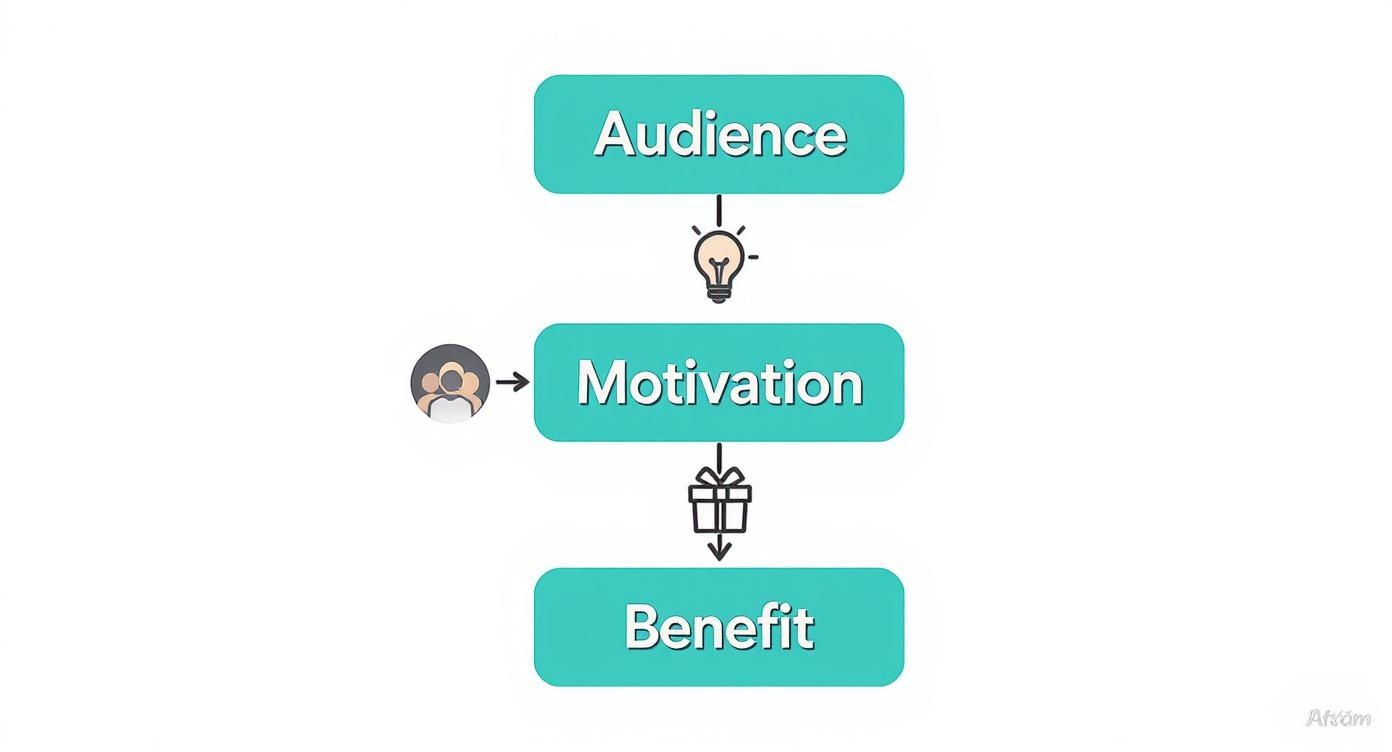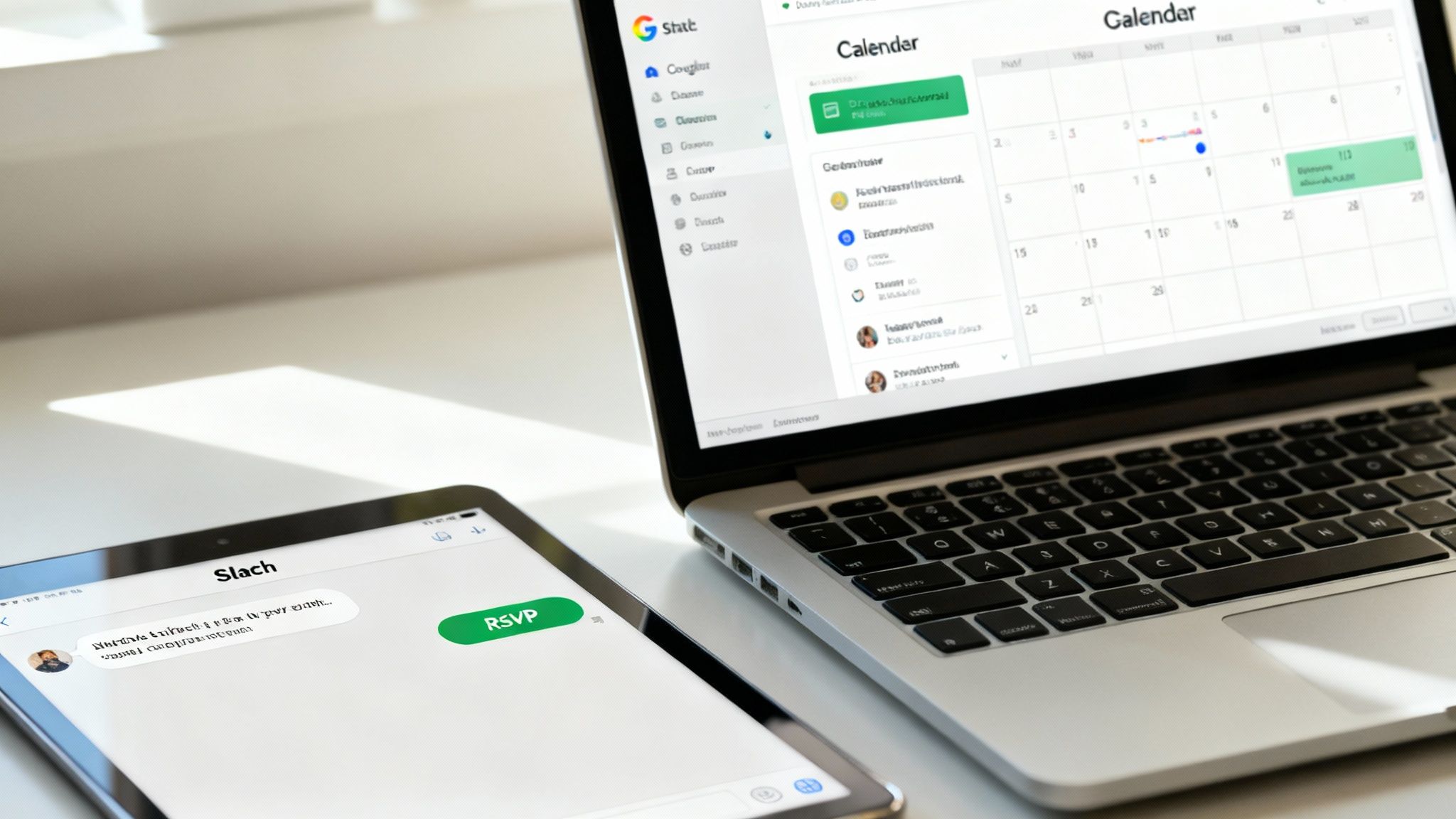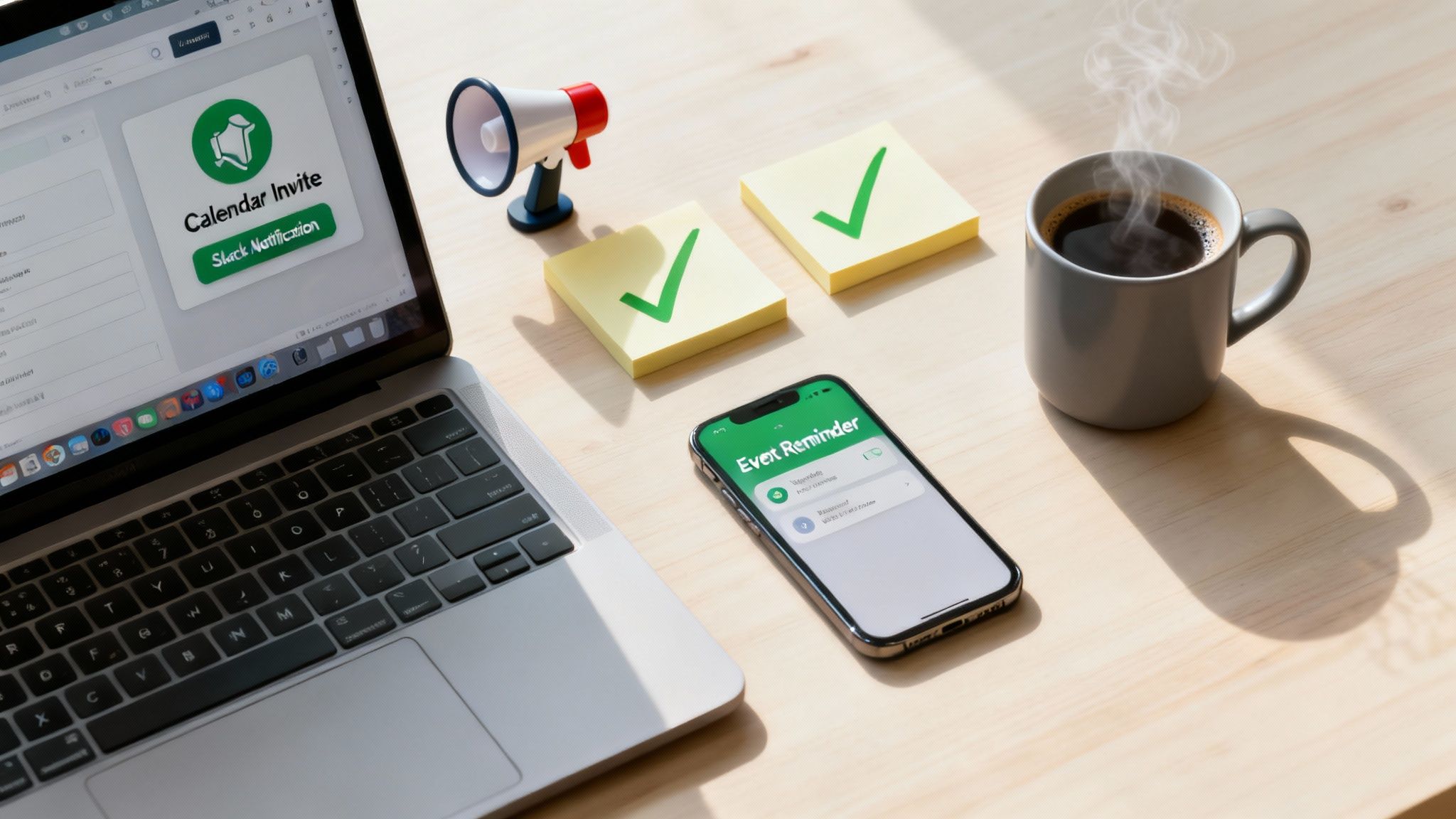Learning how to really nail event promotion boils down to one simple truth: you need a message that truly connects with a specific group of people. Before you get lost in the weeds of channels and tactics, you have to figure out why someone should give you their precious time and attention. This is the foundation everything else is built on.
Crafting Your Event's Core Message
Long before the first invite is sent, your event needs a story. It has to be more than just a date and a location on a calendar; it has to be an experience people don't want to miss. This is true whether you're trying to rally your internal team or attract new clients.
It all starts with getting inside the heads of your audience. Who are you actually trying to reach? What gets them excited? A software developer heading to a tech conference is looking for something completely different than an HR manager attending a company retreat.
✦Get to the Heart of What They Want
To create a message that sticks, you need to speak directly to what your audience actually cares about. Don't just list what's happening—focus on the real-world benefits they'll walk away with. Will they learn a skill that gets them promoted? Will they meet someone who could change their career? Or will they just feel more connected to the people they work with every day?
- For External Events: Think about what drives them professionally. Frame the value around career growth, exclusive knowledge, or game-changing networking opportunities.
- For Internal Events: Focus on the human element. Highlight how the event will build team spirit, celebrate hard-won successes, or bring clarity to the company's mission.
Applying some general marketing and advertising principles can give you a great framework for articulating these benefits clearly.
The best event messages immediately answer the attendee's unspoken question: "What's in it for me?" Make the value so obvious and compelling that showing up feels like a no-brainer, not another obligation.
When you nail the "why," you create a natural buzz that will carry through all of your promotional efforts. If you want to dig deeper into this strategic phase, you can learn more about building a complete https://be-there.co/blog/articles/event-marketing-plan to guide you from start to finish.
Choosing the Right Promotional Channels
You've nailed down your message. Now, where do you shout it from? The best event promotion happens when you meet people where they already are, not where you wish they were. Spreading your message across a few different channels is almost always the smart move, creating a surround-sound effect that's hard to ignore.
Email is still a workhorse for event marketers. It’s your direct line to people who already know you, making it perfect for sending detailed agendas, speaker bios, or a special discount for early birds. If you want to dive deeper, we have a whole guide on crafting an effective email event invitation that gets clicks.
Then you have social media, which is all about creating buzz. LinkedIn is the go-to for professional conferences and B2B webinars, while Instagram or TikTok are fantastic for building visual hype around a festival, product launch, or creative workshop.
It all comes down to connecting the right message to the right channel. I've always found a simple decision tree helps clarify this.

This visual really drives home the point: the who (your audience) and the why (their motivation) should dictate the where (your channels).
Figuring out which platforms to focus on can feel overwhelming, but looking at what each one does best can simplify things.
✦Event Advertising Channel Comparison
| Channel | Best For | Key Metrics |
|---|---|---|
| Nurturing existing contacts and past attendees | Open Rate, Click-Through Rate (CTR), Conversion Rate | |
| Professional events, webinars, B2B audiences | Engagement Rate, Clicks, Registrations from Post | |
| Visually appealing events, B2C, younger audiences | Reach, Story Views, Link Clicks (in bio/stories) | |
| Slack | Internal company events, team-building, training | RSVP Rate, Engagement in Channel, Attendance |
| Facebook Events | Community gatherings, local events, B2C marketing | RSVPs ("Going" vs. "Interested"), Reach, Shares |
This table isn't exhaustive, of course, but it's a solid starting point for matching your event type with the channels most likely to deliver results.
✦Selecting Your Primary Platforms
If you're promoting an internal company event, don't overthink it. Your most powerful channels are the tools your team uses every single day: Slack and Google Calendar. Why fight for attention on a noisy social feed when you can pop up right in their workflow?
This is where a tool like Be-There.co becomes invaluable for any company that relies on both Slack and Google Calendar. It connects your calendar invites directly to Slack, turning a passive calendar entry into an active conversation and making sure your announcement doesn't just get lost in a sea of notifications.
And this digital-first approach isn't just for internal events. The virtual events market is exploding—it’s expected to hit $236.69 billion by 2025, a significant jump from $193.45 billion in 2024. This massive growth just reinforces how critical it is to choose digital platforms that your audience genuinely uses, whether they're across the hall or across the globe.
Boosting Internal Events in Slack and Google Calendar
If your company lives in Slack and Google Calendar, you know the drill. You meticulously set up an event in your calendar, then hop over to Slack to blast out an announcement, crossing your fingers that it doesn't get instantly buried in the #general channel chaos. It’s a clunky, disconnected process that creates extra work and reduces visibility.
What if you could stop juggling platforms? For companies using both Slack and Google Calendar, a tool like Be-There.co is a game-changer. It seamlessly connects your calendar invites to your Slack workspace, turning a simple notification into a lively, interactive announcement right where your team spends its day. It’s not just about sending an invite; it’s about making it dead simple for people to see what’s happening and join in.
✦Unifying Your Internal Communication
This is exactly the kind of headache Be-There.co was built to solve for companies that depend on Slack and Google Calendar. It acts as the missing bridge between your calendar and your main communication hub. When you create an event in Google Calendar, you can push a clean, engaging announcement straight to any Slack channel you choose, eliminating the manual copy-paste process entirely.
This single integration fixes the biggest pain points for internal event organizers:
- No More RSVP Chasing: Employees can RSVP with a single click right inside the Slack message. The best part? Their response automatically updates your Google Calendar event, so you always have an accurate headcount without manual tracking.
- Set-It-and-Forget-It Reminders: Stop manually bumping posts. The system can send out automated reminders in Slack, keeping your event on everyone's radar without you having to lift a finger.
- Centralized Attendance Tracking: By unifying RSVPs between Slack and Google Calendar, you get a single, reliable source of truth for who is attending, streamlining planning and logistics.
Here’s a peek at just how straightforward it is to create a compelling Slack announcement directly from your event.

As you can see, you can easily add rich details like custom images and clear descriptions to make your event post pop in a fast-moving feed.
For companies running on Slack and Google Calendar, the efficiency boost is undeniable. When employees can see details, RSVP, and get reminders all in one place, participation goes up because you've removed the friction.
This integrated approach is a cornerstone of modern internal event promotion. For a deeper dive into organizing successful gatherings from start to finish, check out our complete guide on how to plan events. By connecting the tools your team already uses every day, you’re not just announcing an event—you’re creating a frictionless experience that makes people actually want to show up.
Creating Buzz with In-Person Experiences
Digital promotion gets you reach, but nothing beats a memorable in-person experience for creating true fans. While a slick social media campaign can fill seats, it's the real-world connection that turns attendees into your most powerful promoters. We're talking about experiential marketing—creating tangible, shareable moments that get people genuinely excited.
Think about what you can do before the main event to get people talking. Imagine a pop-up coffee cart near a relevant industry hub or a scavenger hunt with clues dropped on Instagram. You could even host a sneak-peek workshop for a handful of VIPs. These kinds of activations build a groundswell of interest and make people feel part of something exclusive before the doors even open.

✦Fostering a Deeper Connection
The idea is to stop just advertising an event and start crafting an experience from the very first touchpoint. Great event promotion doesn't end once you've sold the ticket. The on-site experience, starting with a hassle-free entry, is what kicks off positive word-of-mouth. To nail that first impression, check out the best check-in apps for events and make sure things run smoothly.
The most effective in-person marketing doesn’t feel like marketing at all. It feels like a genuine, valuable interaction that leaves people feeling seen and excited for what’s to come.
This hands-on approach is really taking off, and for good reason. The numbers don't lie. A staggering 74% of Fortune 1000 marketers plan to increase their experiential marketing budgets in 2025, a clear sign they believe in its power to build loyalty. For a deeper dive, you can see the full analysis of marketing trends.
Strategic partnerships are another fantastic way to get your message out there. Why not co-host a pre-event mixer with a complementary brand? Or feature local artists to tap into their communities? By creating buzz through these tangible experiences, you build a community around your event long before it starts, ensuring the room is filled with energy and enthusiasm from the get-go.
How Do You Know if Your Advertising Is Actually Working?
You’ve put in the work to promote your event, but how can you be sure it’s paying off? Just counting the number of attendees doesn't give you the full picture. To really understand what's working, you need to dig into the right numbers—the ones that tell you how your audience is really responding.
It's easy to get distracted by "vanity metrics" like a high number of likes. But the real story is in the metrics that show genuine interest and action. Things like the click-through rate (CTR) on your registration link or the number of times your announcement was shared tell you so much more about engagement.
✦Tracking the Metrics That Matter
To get a clear view, you need to track performance across the entire event lifecycle: before the doors open, while it's happening, and after everyone's gone home. Each stage offers its own unique clues.
Before the Event: Keep a close eye on ticket sales and registration velocity—that’s the speed at which people are signing up. You’ll also want to watch your traffic sources to see which of your promotional channels are actually sending people to your page.
During the Event: Are people talking? Monitor social media for your event hashtag to see what's being said in real-time. If you have a virtual component, track live engagement to see what’s keeping your audience hooked.
After the Event: This is where the real learning happens. Send out a feedback survey to find out what attendees thought. It's also critical to compare your registration numbers to your final attendance rate to understand your no-show percentage.
This kind of detailed tracking is vital, especially since in-person events are still a massive driver for businesses. A recent report found that 78% of organizers say in-person events are their most impactful marketing channel. You can discover more insights on event marketing statistics that back this up.
Gathering post-event feedback is priceless. It doesn't just tell you what went right; it gives you a clear, actionable roadmap for making your next event promotion even more successful and proving its ROI.
When you get into the habit of tracking these deeper metrics, you stop guessing. You start making smarter decisions, refining your strategy for the next time, and showing everyone exactly how valuable your work is.
Your Top Event Promotion Questions Answered
Even with years of experience under your belt, promoting an event brings up a lot of questions. Getting the timing and strategy right can mean the difference between a full house and an empty room. Let's tackle some of the most common questions we get from organizers.
✦How Far Out Should I Start Promoting My Event?
There's no single magic number here—it really depends on the size and type of your event.
For big-ticket events like a major conference or a trade show, you’ll want to start building buzz 3-6 months ahead of time. This gives you plenty of runway to attract early-bird registrations and build steady momentum.
But for smaller events, like a webinar or an internal all-hands meeting, a shorter window of 2-4 weeks is usually perfect. It keeps the event fresh in everyone's mind without giving the initial excitement a chance to fade.
✦What’s the Most Budget-Friendly Way to Advertise?
When you're promoting to an external audience, your best bet is to start with the channels you already own. Your email list, organic social media posts, and company blog are powerful and often deliver the best return before you even think about paid ads.
For internal events, especially in companies running on Slack and Google Calendar, the answer is even easier: use the tools your team is already in all day, every day.
This is where a purpose-built tool like Be-There.co really shines. Instead of sending out scattered announcements that get lost, you can create one smooth, automated workflow that connects your calendar to your communication hub, maximizing visibility without spending a dime on ads.
✦How Do I Get More People to Show Up for Internal Events?
The secret is to make it ridiculously easy for them to attend. The biggest hurdle for internal events isn't a lack of interest; it's friction. Think about it: a missed email, a calendar invite that gets buried, or a Slack announcement that scrolls by in a busy channel.
You need to meet your team where they are.
A tool like Be-There.co is designed to solve exactly this problem for companies that use both Slack and Google Calendar. It hooks your Google Calendar invites directly into your Slack channels, so you can send out eye-catching, interactive announcements. It also automates reminders and lets you track RSVPs without anyone ever having to leave Slack.
When you remove those small but frustrating barriers, you make it simple for people to say "yes" and actually be there.
Be There is the first event planner built right inside Slack, helping you create, publish, and manage company events without the hassle. Learn more and start your free trial today!

Planning your internal events has never been easier!
No more scheduling headaches—our Slack-connected web app keeps things simple. Less email, more fun! 🚀
